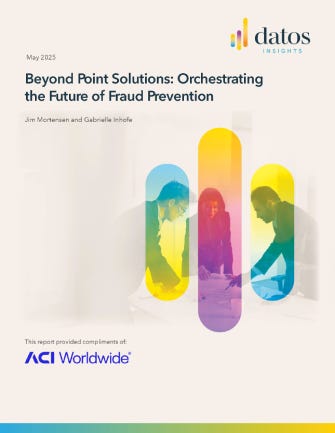Reports: Payments in Change: Where is the journey heading?; Coinbase’s x402 payment protocol; Three ways to unlock growth from agentic commerce;
Let’s dive into this week’s curated collection of fintech reports, whitepapers, and expert guidelines in the latest edition of Fintech Wrap Up. Every resource featured is available for download
Insights & Reports:
1️⃣ Is your fraud strategy stuck in silos?
2️⃣ Payments in Change: Where is the journey heading?
3️⃣ Coinbase’s x402 payment protocol
4️⃣ Three ways to unlock growth from agentic commerce
5️⃣ Buy Now, Pay Later: Reshaping Consumer Credit and Financial Access
6️⃣ What if your platform could become your customers’ bank?
TL;DR:
Welcome to this edition of the Fintech Wrap Up!
Fraud prevention is getting a major upgrade. Instead of juggling disconnected tools, financial institutions are turning to fraud orchestration platforms—centralized systems that connect data across channels, reduce false positives, and enable smarter, faster decisions. With 95% citing siloed data as a top challenge, orchestration is quickly becoming essential. ACI Worldwide’s platform stands out, offering real-time fraud detection and no-code AI tools. The market is projected to hit $3.66B by 2028.
In payments, Thede Consulting outlines five possible futures—from A2A dominance and the rise of the digital euro to the persistence of card networks and emergence of super apps. Regulation is intensifying (PSD3, DORA, FIDA), but no single model is expected to win. Instead, the future looks like complex coexistence.
Coinbase is reimagining online payments with x402—a protocol that enables instant stablecoin transactions via standard HTTP. It unlocks frictionless monetization for apps, APIs, and even AI agents, making microtransactions seamless.
Stripe highlights the rise of agentic commerce, where AI assistants shop on users’ behalf. To stay ahead, businesses need structured product data, API-based checkouts, and programmable payments.
BNPL is no longer niche—128M U.S. adults used it in the past year. Fintechs and banks are racing to offer flexible credit, but rising delinquency (30% past due) is a growing concern.
Lastly, embedded lending is a major growth lever for platforms serving SMBs. With access to rich customer data, platforms can offer revenue-based financing with higher approval rates, better UX, and stronger loyalty.
Thanks for reading Fintech Wrap Up!
Insights
Reports
Is your fraud strategy stuck in silos?
As financial institutions race to keep pace with sophisticated fraud tactics, a new approach is gaining momentum: fraud orchestration platforms.
Traditional fraud prevention relies on a patchwork of point solutions—each tackling a specific risk. But managing these fragmented tools is costly, inefficient, and often ineffective. Enter orchestration: a centralized model that connects disparate systems, unifies risk signals, and enables real-time, multilayered fraud strategies.
The new Datos Insights report, Beyond Point Solutions: Orchestrating the Future of Fraud Prevention, outlines why orchestration is no longer optional.
Here are the key insights:
- 95% of institutions cite siloed data as a top challenge. Orchestration platforms bridge these gaps by integrating internal and external data across all channels.
- Instead of overwhelming fraud teams with alerts, orchestration platforms use ML engines and analytics to intelligently route transactions, reducing false positives and prioritizing high-risk cases.
- These platforms allow no-code strategy building, real-time testing (A/B), and seamless integration with identity verification, behavioral biometrics, device intelligence, and third-party fraud tools—all through APIs.
- Fraud orchestration isn’t one-size-fits-all. The market spans:
- Pure-play platforms (vendor-agnostic decisioning hubs)
- Analytics engines (pattern recognition at scale)
- Identity solutions (fighting account takeovers)
- Hybrid platforms (built-in analytics + third-party flexibility)
- ACI Worldwide’s orchestration platform is a standout, leveraging its payments ecosystem visibility to deliver sub-300ms fraud detection across 6,000+ TPS. Its Model Generator lets fraud teams build AI/ML models without data science skills—democratizing fraud strategy design.
Keep reading with a 7-day free trial
Subscribe to Fintech Wrap Up to keep reading this post and get 7 days of free access to the full post archives.




